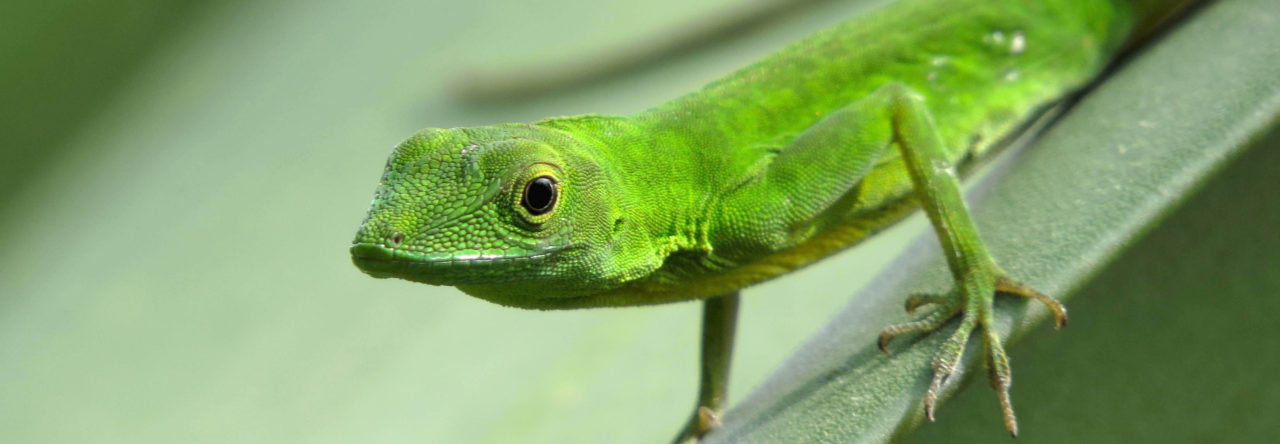
Anolis nubilus male and female from The Anoles of the Lesser Antilles.
In 1972, James “Skip” Lazell published a monograph on the Anoles of the Lesser Antilles including the species description of Anolis nubilus, an endemic anole restricted to the island of Redonda. His description of the animal and island, like the rest of the monograph, is colorful and evocative:
“The tiny islet is exceedingly steep-to, and rises nearly 1000 feet out of the sea. There is virtually no surrounding bank, and the full swell of the western North Atlantic pounds Redonda’s cliffs. A tiny, nearly vertical gut on the leeward side provides the only access to the top of the islet up the cliffs; great blocks of basalt lie at the foot of this gut and one’s original entrance to Redonda is made by jumping onto these blocks as the boat goes past them. It is about like jumping from a moving elevator onto a card table, except that elevators give more notice of directional reversals… but getting on is just the beginning. …
The top of Redonda is a rolling wold and a favorite place of innumerable nesting sea birds; the gut provides a route for their guano to descend the cliffs, and it dries to a thick powder there. Because of its lee-ward location, a chimney effect is produced in the gut, and the guano dust, mixed with the volcanic sand weathered from the parent rock, tends to rise when disturbed. As one toils up the gut under the tropical sun, one is accompanied by a cloud of this dust, which soon mingles with one’s own sweat to produce a wondrously aromatic and abrasive, though rather gluey, bath. At the top, jumbles of rocks and clumps of prickly pear rise gently to the old ruins, complete with a hedge of bougainvillea and a single tree. This is the home of Anolis nubilus. …
Surely Redonda once supported more vegetation, and presumably Anolis nubilus then had an easier life. The feral goats should be extirpated on this remarkable island, whose only known nonflying vertebrates are species found nowhere else on earth.”
Now, 45 years, 1 week, and 4 days later, I’m headed to Redonda to gather baseline lizard data on exactly such a goat extirpation.
Skip did miss one nonflying vertebrate in his account; Rattus rattus has taken up residence en masse on Redonda. The black rats are so plentiful now that they’ve taken to stalking the lizards on the island in daytime—“tiger rats,” according to Dr. Jenny Daltry, one of the researchers leading the island restoration effort. And so, the government of Antigua and Barbuda, in conjunction with numerous conservation NGOs including Flora and Fauna International, has decided to remove the goats and rats from Redonda in an attempt to restore the island and help its three endemic lizard species to recover.
Redonda is home to not just A. nubilus but also a jet black ground lizard, Ameiva atrata and an as-yet unnamed dwarf gecko, Sphaerodactylus sp. Presumably, A. nubilus would be perched high in vegetation avoiding the roving A. atrata; however, after centuries of goat grazing on Redonda, that vegetation has been reduced to a single Cassuarina tree. So, while that tree is likely swarming with anoles, most of the A. nubilus are spending their time hopping around the boulders of Redonda. Normally this would put them in range of the roving ground lizards, but it sounds as though both lizards should be more worried about those hungry black rats.
Fortunately for all of Redonda’s reptiles, as of a few weeks ago the goats on the island took a one-way ferry ride to new pastures (not a euphemism) and, well, starting soon the rats will be making their way to the great big garbage heap in the sky (definitely a euphemism). My goal is to get to Redonda and gather as much baseline data on the lizards as possible to see whether and how the lizard community changes on a goat-less, rat-free Redonda.
That’s no easy task, though. Here’s a picture of Redonda:

Photo credit: Dr. Jenny Daltry. I’m reasonably sure that’s the gut there, in the foreground of the image.
Believe it or not, that’s the pleasant side of the island. Here’s the other:
We decided that hauling a week’s worth of research and camping gear up Lazell’s gut (let alone jumping to that card-table basalt) was out of the question, so I’m going to be arriving by helicopter. As if the rats weren’t enough, Redonda has no source of fresh water so we’ll be carrying in food and drink for the 8 days on the island. No power either, so I’ve been putting together solar kits to try to get enough juice to run a computer and spectrophotometer.
All in all, it’s going to be an adventure! I’ll update Anole Annals when I return, but I’ll also be posting more frequent updates to my personal blog and twitter. I’d love to hear from you, especially if you have any tips for rat-proofing tents (seems more efficient to just bait the other ones, right?).
Citation: Lazell, J.D. 1972. The Anoles (Sauria, Iguanidae) of the Lesser Antilles. Bulletin of the Museum of Comparative Zoology. 143(1).
















